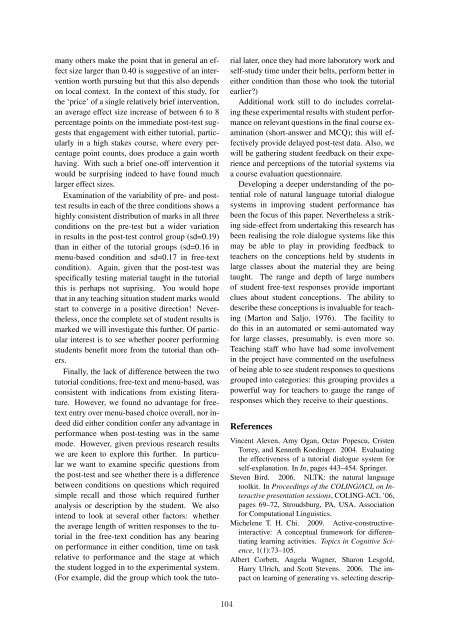Full proceedings volume - Australasian Language Technology ...
Full proceedings volume - Australasian Language Technology ...
Full proceedings volume - Australasian Language Technology ...
You also want an ePaper? Increase the reach of your titles
YUMPU automatically turns print PDFs into web optimized ePapers that Google loves.
many others make the point that in general an effect<br />
size larger than 0.40 is suggestive of an intervention<br />
worth pursuing but that this also depends<br />
on local context. In the context of this study, for<br />
the ‘price’ of a single relatively brief intervention,<br />
an average effect size increase of between 6 to 8<br />
percentage points on the immediate post-test suggests<br />
that engagement with either tutorial, particularly<br />
in a high stakes course, where every percentage<br />
point counts, does produce a gain worth<br />
having. With such a brief one-off intervention it<br />
would be surprising indeed to have found much<br />
larger effect sizes.<br />
Examination of the variability of pre- and posttest<br />
results in each of the three conditions shows a<br />
highly consistent distribution of marks in all three<br />
conditions on the pre-test but a wider variation<br />
in results in the post-test control group (sd=0.19)<br />
than in either of the tutorial groups (sd=0.16 in<br />
menu-based condition and sd=0.17 in free-text<br />
condition). Again, given that the post-test was<br />
specifically testing material taught in the tutorial<br />
this is perhaps not suprising. You would hope<br />
that in any teaching situation student marks would<br />
start to converge in a positive direction! Nevertheless,<br />
once the complete set of student results is<br />
marked we will investigate this further. Of particular<br />
interest is to see whether poorer performing<br />
students benefit more from the tutorial than others.<br />
Finally, the lack of difference between the two<br />
tutorial conditions, free-text and menu-based, was<br />
consistent with indications from existing literature.<br />
However, we found no advantage for freetext<br />
entry over menu-based choice overall, nor indeed<br />
did either condition confer any advantage in<br />
performance when post-testing was in the same<br />
mode. However, given previous research results<br />
we are keen to explore this further. In particular<br />
we want to examine specific questions from<br />
the post-test and see whether there is a difference<br />
between conditions on questions which required<br />
simple recall and those which required further<br />
analysis or description by the student. We also<br />
intend to look at several other factors: whether<br />
the average length of written responses to the tutorial<br />
in the free-text condition has any bearing<br />
on performance in either condition, time on task<br />
relative to performance and the stage at which<br />
the student logged in to the experimental system.<br />
(For example, did the group which took the tutorial<br />
later, once they had more laboratory work and<br />
self-study time under their belts, perform better in<br />
either condition than those who took the tutorial<br />
earlier?)<br />
Additional work still to do includes correlating<br />
these experimental results with student performance<br />
on relevant questions in the final course examination<br />
(short-answer and MCQ); this will effectively<br />
provide delayed post-test data. Also, we<br />
will be gathering student feedback on their experience<br />
and perceptions of the tutorial systems via<br />
a course evaluation questionnaire.<br />
Developing a deeper understanding of the potential<br />
role of natural language tutorial dialogue<br />
systems in improving student performance has<br />
been the focus of this paper. Nevertheless a striking<br />
side-effect from undertaking this research has<br />
been realising the role dialogue systems like this<br />
may be able to play in providing feedback to<br />
teachers on the conceptions held by students in<br />
large classes about the material they are being<br />
taught. The range and depth of large numbers<br />
of student free-text responses provide important<br />
clues about student conceptions. The ability to<br />
describe these conceptions is invaluable for teaching<br />
(Marton and Saljo, 1976). The facility to<br />
do this in an automated or semi-automated way<br />
for large classes, presumably, is even more so.<br />
Teaching staff who have had some involvement<br />
in the project have commented on the usefulness<br />
of being able to see student responses to questions<br />
grouped into categories: this grouping provides a<br />
powerful way for teachers to gauge the range of<br />
responses which they receive to their questions.<br />
References<br />
Vincent Aleven, Amy Ogan, Octav Popescu, Cristen<br />
Torrey, and Kenneth Koedinger. 2004. Evaluating<br />
the effectiveness of a tutorial dialogue system for<br />
self-explanation. In In, pages 443–454. Springer.<br />
Steven Bird. 2006. NLTK: the natural language<br />
toolkit. In Proceedings of the COLING/ACL on Interactive<br />
presentation sessions, COLING-ACL ’06,<br />
pages 69–72, Stroudsburg, PA, USA. Association<br />
for Computational Linguistics.<br />
Michelene T. H. Chi. 2009. Active-constructiveinteractive:<br />
A conceptual framework for differentiating<br />
learning activities. Topics in Cognitive Science,<br />
1(1):73–105.<br />
Albert Corbett, Angela Wagner, Sharon Lesgold,<br />
Harry Ulrich, and Scott Stevens. 2006. The impact<br />
on learning of generating vs. selecting descrip-<br />
104














